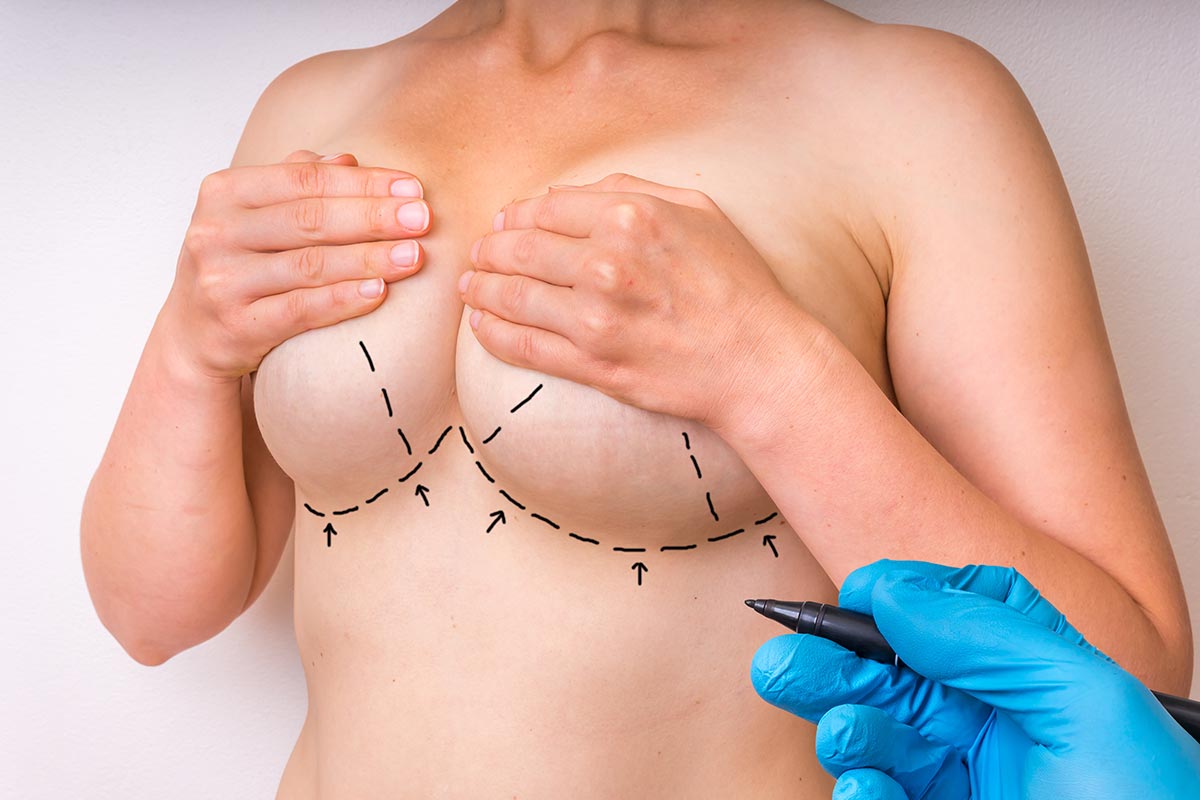
Breast lift surgery reshapes the breasts but it usually results in scars. As these scars mature, their look can alter. Proper care is key to managing scars well, particularly after the first six months of healing.
Dr. Gabriel Salloum, a seasoned expert in cosmetic procedures, provides professional recommendations for scar care. By adhering to his instructions, you can reduce the visibility of scars and support the healing process, aiming for the best results post-breast lift.
Caring for Breast Lift Scars Over Time
- Even after six months, breast lift scars continue to heal and fade, with proper care enhancing their appearance.
- Using sunscreen on breast lift scars is essential as they can darken if exposed to the sun.
- Silicone gel or sheeting can be effective in managing breast lift scars by keeping the area hydrated and protected.
- Massaging the scars gently can improve their texture and promote better healing.
- Consult with a healthcare provider for personalized advice if concerns about breast lift scars persist beyond six months.
Understanding Breast Lift Scars and Their Evolution
Breast lift scars, known as mastopexy scars, change over time. They start as red and slightly raised but tend to lighten to match the natural skin tone and the scar tissue becomes smoother as the healing process progresses.
The appearance of mastopexy scars varies with factors like skin pigmentation and individual healing abilities. Those with light skin may notice scars that fade to a thin white line, while those with darker skin could see scars that become slightly darker and then stabilize closer to their natural skin tone.
For optimal breast scar reduction, follow these steps:
- Get prompt medical care
- Take proper care of the wound
- Follow post-surgery guidelines carefully
Staying informed about the nature of healing breasts can help manage expectations regarding breast surgery scars and support positive recovery.
Step 1: Evaluate the Current State of Scarring

Monitoring the state of scars after a breast lift is crucial for evaluating the skin during recovery. Scars are expected to change from red or pink to a paler tone, resembling the surrounding skin color. A scar gel with silicone can promote a smoother texture and help in the transition, lessening visible scarring.
Scars that remain flat and smooth indicate positive breast lift surgery recovery. Look for these signs of proper healing:
- Intact skin with no signs of reopening
- Gradual color change to a less noticeable shade
- Absence of continuous redness or irritation
Noteworthy, the healing process is unique to each person, but attentive care can enhance the appearance of breast lift surgery scars. Regular observation is advised to track the progress and set realistic expectations for the result of your breast lifts.
Step 2: Implement Scar Massage Techniques
When massaging breast lift scars, it’s important to use the appropriate oils and creams to aid the healing process. Products rich in vitamin E can moisturize the skin and support collagen production, vital for scar treatment. Coconut and rosehip oil are good options for their beneficial properties.
Massage is a strategic approach to improving blood circulation and scar healing. Start with gentle, non-aggressive movements. Use these methods to massage the scar:
- Circular motions boost collagen production and soften the scar tissue.
- Vertical and horizontal strokes promote flexibility in collagen fibers.
- Gentle tapping near the scar to enhance blood flow without excess pressure.
Regularly apply these methods in your care routine. A consistent approach with appropriate products leads to better scar appearance and texture.
Step 3: Explore Professional Scar Treatment Options
Silicone-based products such as silicone sheets are recommended for the management of keloid and hypertrophic scars, delivering promising results in scar reduction after breast surgery. These sheets, which patients apply directly to the skin, work to flatten and soften the scarred area. For users requiring a more flexible option, silicone gels can be applied, especially on varied body parts where sheets might not adhere well.
Silicone sheets and gels function through sustained skin contact. For best results, it’s important to adhere to a daily routine, with the following steps:
- Place silicone sheets over the scar consistently.
- For gels, apply directly and allow to form a hydrating barrier.

Steroid injections are another professional treatment for breast reduction scars, particularly beneficial for keloid scars. These are commonly administered in a series of sessions by a healthcare provider and can help alleviate discomfort. Additionally, laser therapy offers a non-invasive approach to enhance the scar’s appearance by improving its color and texture and is often performed across multiple appointments by certified experts.
Silicone treatments can be self-applied, while steroid injections and laser therapy should be conducted by professionals. These methods collectively offer effective avenues for individuals to improve the aesthetic outcome post-breast surgery.
Step 4: Protect and Nourish Your Skin
Good skin care is crucial after a breast lift. It’s important to guard your skin, especially scars, from sun damage. Sun can darken scars, contrasting sharply with your natural skin tone. Use a high-SPF sunscreen daily to provide sun protection and help scars heal without changing color.
Nutrition is key in managing scars and maintaining skin health. A diet rich in vitamins supports skin elasticity and repair. For effective scar management:
- Include vitamins A and C to boost collagen and aid in wound repair.
- Add Zinc supplements to keep skin in good condition.
- Apply Silicone treatments to keep the scar area hydrated, possibly reducing uneven textures.
Together, responsible sun protection and a diet supplemented with key vitamins and treatments promote conditions favorable for scars to heal well, blending into the surrounding skin and maintaining a consistent natural skin tone.
Please incorporate these elements into your skincare routine after any surgical procedure to ensure the best results for your skin.
Breast Lift Before and After Pictures
 Explicit content – Discretion advised.
Explicit content – Discretion advised.
 Explicit content – Discretion advised.
Explicit content – Discretion advised.
*All patients are unique and individual results may vary.
Step 5: Incorporate Healthy Habits into Your Routine
Diet and Skin Health
Adopt a diet that supports the body after a breast lift by focusing on foods that boost skin elasticity and aid in scar healing. Include:
- Lean proteins to repair tissues
- Vitamin C-rich fruits to support collagen
- Plenty of water to stay hydrated
A proper diet also helps manage excess skin and is essential for recovery from surgical procedures like breast lifts and breast reduction.
Effects of Smoking and Drinking
Smoking and alcohol consumption can negatively impact healing after a breast lift. Surgeons will recommend patients to stop smoking and reduce alcohol intake as these practices can diminish blood flow and skin’s repair capability. Smoking specifically can lower skin elasticity, hindering the fading of scars. Key points to consider:
- Smoking slows down healing and can worsen scarring
- Alcohol leads to dehydration, compromising skin quality
- Steering clear of these substances helps in achieving better surgical outcomes
The content should emphasize the importance of establishing healthy habits as part of the recovery process from a breast lift or other related surgical procedures, ensuring the health of your skin remains a priority.
Step 6: Consider Non-Invasive Home Remedies

Natural oils offer benefits for the healing and appearance of breast lift scars. Comprising moisturizing qualities, they maintain natural skin tone and improve the elasticity of the scar tissue. Oils such as vitamin E and rosehip are beneficial due to their antioxidants, which enhance blood flow to the scar area and support a less noticeable scar over time. Before applying anything to your scars, it’s vital to get the approval of your surgeon during your healing process.
For a simple home remedy, mix the following:
- 2 tablespoons of aloe vera gel to support blood flow and natural skin tone.
- 5 drops of rosehip oil for enhancing natural skin tone.
- Optionally, add 2 drops of lavender oil for its calming effects.
Stir these ingredients until evenly mixed, then gently apply to your scars, taking care not to interfere with the healing. As you do this, maintain communication with your surgeon about any treatments you’re considering.
This blend of natural ingredients nurtures the skin’s collagen fibers, promoting more efficient repair.
Step 7: Know When to Consult Your Surgeon
Monitoring Changes in Scars
It’s important to check your scars after a breast lift for any unusual changes. If you see increased swelling or redness, color changes, discomfort, or signs of infection such as warmth and discharge, reach out to your surgeon. These may mean you require a breast lift scar revision.
Preparing for Follow-Up
Before your follow-up appointment, be ready with a list of questions and note any changes. Take photos for your surgeon to review and update them on any new medications or supplements. Timely communication with your surgeon is key to managing your scars effectively.
- Questions: Note new symptoms or changes.
- Photos: Document changes with photos.
- Medication update: Inform your surgeon of any new medications.
Seeing unusual changes? Schedule a consultation appointment with your experienced surgeon promptly.
Scar Care After Breast Lift Surgery
Proper Attire Selection
Breast lift patients should be mindful of their attire. Tight or restrictive clothing can interfere with blood supply and may cause scarring. It’s advisable to wear loose-fitting clothes and avoid:
- Rough textiles that could irritate the anchor incision pattern
- Tight bands on or near the scars
- Attire that constricts movement or causes discomfort
Recommended Activity Limitations
It’s essential to consider your activities when managing scars. To promote proper healing:
- Avoid exercises that involve forceful chest movement
- Minimize actions that might stretch or pull at the area of the anchor breast lift
- Take care not to disturb blood supply with intense upper body workouts
These precautions help ensure the successful healing of scars and aid in preserving the improvements from your breast lift.


SPECIALIST CARE YOU CAN TRUST
Dr. Salloum is supported by a brilliant team of caring staff members.
You can trust the entire staff to help make your visit as comfortable and safe as possible!
Precautions to Prevent Scar Deterioration
Protecting your breast lift scars from potential damage is essential. Watch out for materials or clothing that could exert excessive tension or pressure on the scars, as these can disrupt healing. Silicone patches are beneficial, providing a safeguard and moisture to the scar.
Silicone patches should be used as recommended by your healthcare provider, and they are effective in minimizing scars if applied consistently. The right timing and adherence to the suggested breast lift technique can significantly improve scar appearance. Consistent scar care is key for optimal results.
- Avoid clothing that causes undue tension
- Use silicone patches to protect and hydrate scars
- Follow exact timing and instructions for scar care
- Consistent care improves scar appearance
Anticipating Results and Managing Expectations
When preparing for the outcomes of a breast lift, it’s crucial to have realistic expectations, particularly when it comes to the evolution of breast lift scars. Scars tend to improve significantly by the six-month mark, although they haven’t yet reached their final stage. Initially, more noticeable and pinkish, scars generally fade to a paler shade over time.
Different types of breast lift procedures, such as a vertical lift, may lead to varied patterns of scarring. It’s essential to know that while breast lift scars are permanent, they often become subtler as time passes. This knowledge is key for managing expectations and cultivating a positive outlook on the lasting effects of cosmetic surgery.
Navigating Emotional and Psychological Aspects of Scarring
The period following a breast lift involves both physical and emotional elements. The objective of breast lift surgery is often to improve body image, yet individuals react differently to the visibility of scars. A plastic surgeon is essential in setting realistic expectations and addressing any worries. The psychological impact of scars can sometimes be significant, even when the surgery provides a boost in self-esteem from breast augmentation. Recognizing these emotional reactions as a part of recovery is important. Continuous communication between the patient and surgeon is crucial, ensuring that emotional health is as well-attended to as physical recovery during the breast lift recovery time.
Summary of Effective Scar Management Strategies
Effective strategies for managing breast lift scars are crucial to the success of breast augmentation surgery. At the six-month mark, patients should consider:
- Regular check-ups with their cosmetic surgeon to observe the progress of scar healing.
- Adhering to a recommended scar management routine to support proper healing.
- Exploring safe non-invasive treatments if suggested by their healthcare professional.
These steps can lead to better healing of breast implants and their associated scars. Consistency and communication with your healthcare team are key.
For effective management of breast lift scars, it’s best to get advice from an expert. Dr. Gabriel Salloum is a board-certified plastic surgeon with a strong background in both general and plastic surgery. He brings a wealth of knowledge to scar treatment, honed through extensive training and a commitment to patient care.
Schedule a consultation with Dr. Salloum to benefit from his expertise in scar care. His dual board certification and experience in reconstructive and cosmetic surgery, combined with a dedication to helping patients feel confident, make him an ideal choice for guidance and treatment options.